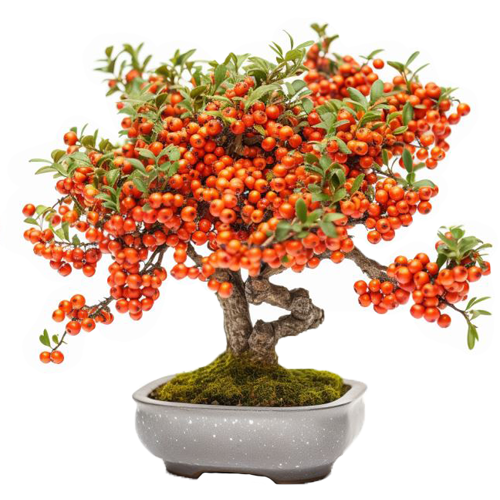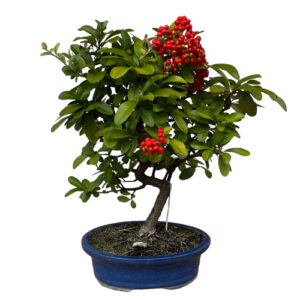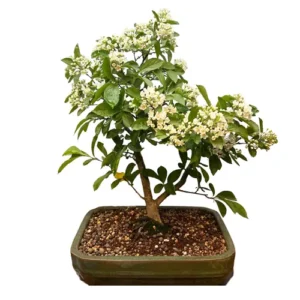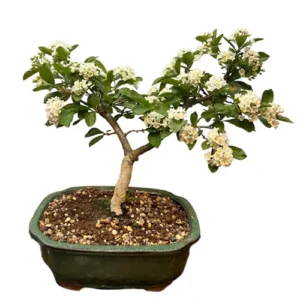Pyracantha
Firethorn Bonsai
The Pyracantha genus are native to the Mediterranean and found as small trees and shrubs. In spring it produces small white flowers, followed by bright red or orange berries in the autumn. Firethorns are easy to care for and respond well to pruning.

Firethorn Bonsai Care Tips
Placement
Choose an outdoor location that receives full sun but is protected from strong wind and scorching sunlight in the hottest part of summer days.
During winter, your firethorn will require a dormant period (approx. 3 months) which can be achieved with temperatures around 2-12 °C. However, it is important to protect from temperatures lower than this and especially frost. This can be done by moving your firethorn to a cold frame or unheated greenhouse.
Watering
There is no definitive guide to watering and it should be conducted on an observational schedule, not a routine. This means that it is important to keep an eye on the moisture levels of the soil to avoid over and under watering, both which can lead to dropping leaves and/or root death. The amount of water a bonsai requires depends on pot size, climate, airflow, soil and tree type so it is best to use your eyes and fingers to assess whether the soil is damp, wet or dry.
If the top inch or so of soil has dried, it is ready to be watered. When you water, try to get an even coverage over the roots and soil, allowing water to flow out from the bottom of the pot to ensure a good soaking.
If you are a first-time bonsai owner, another way to water is by submerging the entire pot in water until the bubbles stop. If you choose this method, be aware that your bonsai may not need watering for another two to four days, but this will depend on the factors mentioned above such as soil type, pot size and climate.
Feeding & Fertilising
Using fertiliser on your firethorn will help encourage healthy growth and this should be done periodically from once a week to every two months and only during the growing season. You can start adding Chrysal Liquid Bonsai Feed to your water from March until October and use weekly. Use Naruko Fertiliser Slow Release Bonsai Feed once every one to two months. With Buddhist Pine trees, less is more, and we tend to advise using half the recommended dosage to see how your Buddhist Pine reacts first.
Pruning & Wiring
Pruning your bonsai is important not only to maintain or create an aesthetic style but to also ensure light and airflow can reach inner leaves and the firethorn bonsai tolerates hard pruning very well. During the early to late spring months use appropriate tools to cut back stems which have grown longer than four leaves, leaving the two leaves which are closest to the stem intact. You can remove large leaves at any time to encourage smaller, more compact ones.
Training your bonsai using wiring is possible but take care of the thorns. The older the branches become, the more brittle and hard they get and can break easily. New shoots are best wired after summer. We recommend using wires with a thickness that matches the thickness of the branch: if the wire you choose is too thick you will damage the bark. If it is too thin, it won’t be effective.
Repotting
Repotting your tree is an important way to provide a fresh and suitable soil mix and ensure appropriate root health. Repot in early spring. Generally, your firethorn will need to be re-potted once every two years if it is young, while older ones can stay in their pots for longer. However, you should always check if it has become root-bound before you change pots. You can do this by lifting the tree gently out of the pot by the main trunk and examining the root system. You will know it is ready if you can see that the roots are circling around each other and the pot. If, however, they still appear contained in the soil, you should place it back and wait until the following spring to check again.
Trees that are ready for repotting will require root pruning, a suitable new pot and appropriate soil mix.
When repotting, do not cut back the root mass by a large amount, and choose a well-draining soil mix that has a neutral or slightly higher PH value of 5-6 but not over 7. We tend to use a mixture of different speciality bonsai soils on our trees. Every species is different so please contact us for free soil-mix advice or to take advantage of our repotting service.
Bonsai trees aren’t only magnificent additions to an indoor oasis, they are more than capable of standing out in any garden. Many Bonsai species are incredibly hardy and withstand nature’s colder and damper turns with aplomb making them worthwhile outdoor plants. We have an extensive library of care guides for outdoor bonsai trees. It’s not about selecting the perfect bonsai, it’s about selecting the perfect bonsai for you.
Firethorn Bonsai - Typical Queries
How to propagate a Firethorn Bonsai?
The Firethorn bonsai can be propagated by seeds, cuttings, or grafting. Seeds can be sown in spring or autumn, but they may take a long time to germinate and may not produce true-to-type plants. Cuttings can be taken in summer from semi-hardwood stems, and rooted in moist soil or sand. Grafting can be done in winter or early spring, by attaching a scion from a desired variety to a rootstock of another Pyracantha.
How to deal with pests and diseases on a Firethorn Bonsai?
The Firethorn bonsai may be affected by various pests and diseases, such as aphids, scale insects, spider mites, fire blight, scab, and rust. The Firethorn bonsai should be inspected regularly for any signs of infestation or infection, and treated accordingly. The Firethorn bonsai should be sprayed with a mild insecticide or fungicide, or a homemade solution of soap and water, to control the pests and diseases. The Firethorn bonsai should also be kept clean and healthy, by removing any dead or diseased leaves and branches and avoiding overwatering or underwatering.























